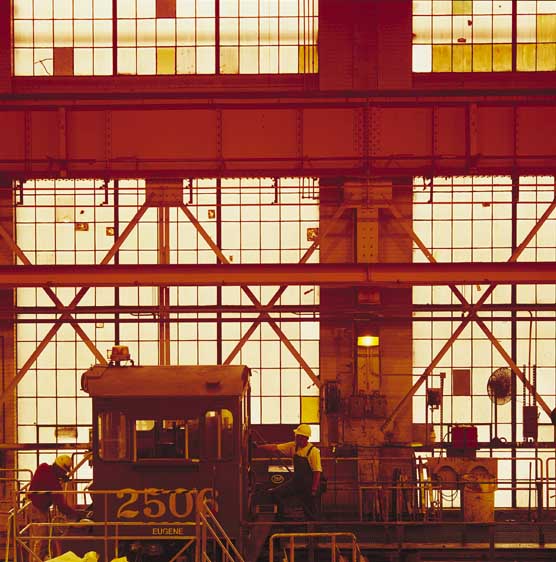| The
locomotive’s engine and its components then go through a number of staging areas,
each staffed by specialized machinists:
-- At the heavy metal fabrication area, machinists upgrade the switch units from water
to electric cab heat.
--In the sheetmetal area, a line of toilets sit, waiting to return to the privacy of
their cabins.
--Craftsmen toil over exhaust stacks, each stripped and qualified to ensure there are
no cracks. The last thing you need is an exhaust leak," Spiva says.
--Bright chrome crank shafts are closely inspected for cracks around their journals and
counterweights before they’re remounted.
--Racks of shiny-clean gears, some a couple of feet across, also await the inspector's
eye.
--In the machine shop, special equipment cuts through bolts of all sizes, using lasers
for special cuts.
All the parts are brought together at three stations. After the engine block leaves the
washing machine, it undergoes a quality check to ensure there are no defects. The engine
bore -- where the piston slides inside the engine -- is measured with a laser to guarantee
perfect straightness. If the bore is off, the engine block goes back for reboring.
At the rebuild station, pressure tests are conducted for oil, water and air leaks.
"We do as much testing off the locomotive as possible before we put it all back
together," Spiva says.
The shop examines, rebuilds or replaces almost every part of the locomotive, from its
electrical systems to the engineer's seat, before reassembly. During the shop's third
shift, the locomotive is lifted from large mounting stands using two massive
125-ton-capacity cranes and placed once again on its reconditioned trucks -- a 20-minute
job. The engine then is placed back in the unit at Locomotive Spot 2.
Minor tests are made before the locomotive is moved to Spot 9, the load-test area just
outside the shop doors. There, a team of craftsmen conduct a battery of tests that the
locomotive must pass before it's released, says Supervisor Ron Gaidies.
Gaidies, who started his railroad career 27 years ago in the Signal Department, says he
learned the craft though "the school of hard knocks. You do the work and do a lot of
studying. Each locomotive is different, and each might have a unique problem. There's a
lot of troubleshooting involved and the knowledge to figure out what's wrong only comes
from experience. Each employee is a specialist, but their pride can't be too big that they
can't swallow it and ask questions when there's something wrong."
The Running Repair Track
At
a glance, it resembles a boat dock, with parked locomotives instead of floating ships. The
Running Repair track is six tracks adjacent to the heavy repair shop, where employees
conduct scheduled inspections, as well as unscheduled maintenance that sometimes involves
detective work.
Before a unit enters the repair track, Machinist/FRA Inspector Jim Chance gives it a
once-over, conducting load tests, inspections and self diagnostics. Though his main focus
is making sure the unit meets Federal Railroad Administration specifications, he also
helps the repair track's machinists figure out what's wrong with those in for unscheduled
maintenance.
"We've had locomotives come in reported with fire out of the stack," Chance
says, "That could be anything from a bad turbine to bad injectors. Black smoke out
the stack could mean a bad cylinder or a hole in the piston. The tests usually give us the
answers." |

